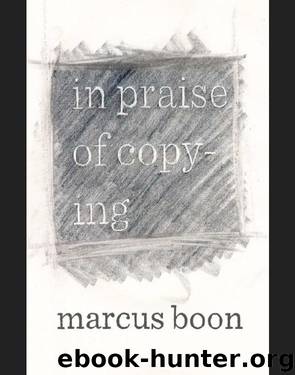In Praise of Copying by Boon Marcus

Author:Boon, Marcus
Language: eng
Format: epub
Publisher: HarvardUniversityPress
Published: 2011-03-28T04:00:00+00:00
5/ Montage
Cornell’s Boxes
So far, we’ve been concerned with copies that more or less involve a whole imitating a whole. It’s true that Elias Canetti’s observations on the different degrees of transformation already suggest a difference between a mere surface or superficial imitation and a total interior and exterior transformation. But even in these situations, one assumes the presence of a whole. Canetti’s donkey dressed in a lion skin is either taken to be a lion or revealed in fact to be a donkey. Kafka’s ape says he has no choice but to consider himself a man now. According to the film Divine Horsemen, when the loa take over worshipers in voodoo rites, they do so completely. Objectively, of course, the old body is there at least. I am concerned less with the objective truth of the situation than with the belief—the valuation of imitation as involving “complete states.” “A copy” is usually a copy of something.
In Joseph Cornell’s assemblage A Parrot for Juan Gris (1954), a parrot painted onto a cut piece of wood sits perched in a wooden box, as if in a birdcage. Several metal rings hang from the box; its sides are covered with newspaper clippings and pieces of old maps, which are superimposed so that they obscure and interrupt each other. On the floor of the box is a white plastic ball. Is Cornell’s box a copy? Not if we think of copying as being concerned with a whole imitating a whole (though, interestingly, Cornell made at least four different versions of A Parrot for Juan Gris, using different clippings and objects but producing a recognizably similar form). Yet, assembled out of fragments or samples of mass-produced objects, the box does imitate a parrot in a cage, and it works because of the way it leverages many of the peculiar powers we have already examined that constitute copying as creative act.
Cornell’s boxes reappear in William Gibson’s cyberpunk novel Count Zero as an early metaphor for the radical disjunctures of cyberspace. In the world of computers, “cut and paste” is a dominant metaphor; more broadly, fragmentation, pastiche, and juxtaposition are characteristic of postmodernity. Indeed, art critic Nicolas Bourriaud has claimed that montage, and other practices of citation, repetition, and appropriation, constitute the core of a contemporary art practice which he variously names “relational aesthetics” and “postproduction.”1 Bourriaud situates this centrality of montage within the context of globalization, the culture of the DJ as curator, selecter, and sequencer of a vast historical and geographical archive, and the Internet as a limitless virtual space of assemblages governed by the logic of the click and the hypertextual trace. Montage also plays a key role in contemporary critical theories, from Derrida’s theory of the trace, to Deleuze and Guattari’s assemblages and disjunctive syntheses, to Badiou’s ontology of the pure multiple and Latour’s actor networks. In summary, a logic of montage is pervasive today, and as soon as we speak of acts of imitation without essence, this logic asserts itself as the construction of the similar from the dissimilar.
Download
This site does not store any files on its server. We only index and link to content provided by other sites. Please contact the content providers to delete copyright contents if any and email us, we'll remove relevant links or contents immediately.
Social Media Law in a Nutshell by Ryan Garcia & Thaddeus A Hoffmeister(1510)
You Don't Own Me by Orly Lobel(1421)
Intellectual Property Strategy by John Palfrey(1397)
Hello, My Name is Awesome by Alexandra Watkins(1335)
Without Copyrights by Spoo Robert(1326)
Profit From Your Idea: How to Make Smart Licensing Deals by Attorney Richard Stim(1313)
The Trademark Guide by Lee Wilson(1213)
Democracy of Sound by Alex Sayf Cummings(1198)
A Triumph of Genius: Edwin Land, Polaroid, and the Kodak Patent War by Ronald K. Fierstein(1185)
The Copywriter's Handbook by Robert W. Bly(1164)
Kafka's Last Trial by Benjamin Balint(1146)
World War 3.0 by Ken Auletta(1140)
Data Protection: A Practical Guide to UK and EU Law by Carey Peter(1123)
What They'll Never Tell You About the Music Business by Peter M. Thall(1079)
BVR's Guide to Intellectual Property Valuation by Michael Pellegrino(1060)
Mass Media Law by Pember Don & Pember Don(1060)
The Tech Contracts Handbook: Software Licenses and Technology Services Agreements for Lawyers and Businesspeople by David Tollen(1055)
Patent It Yourself: Your Step-by-Step Guide to Filing at the U.S. Patent Office by Pressman David Attorney(1046)
Hello, My Name Is Awesome: How to Create Brand Names That Stick (BK Business) by Alexandra Watkins(1044)
